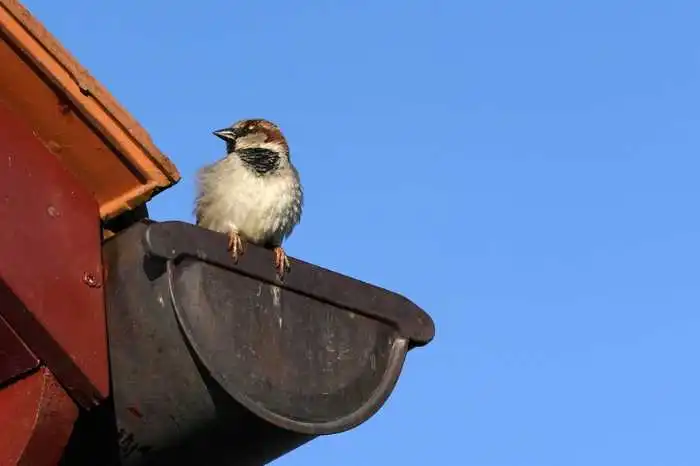Cicadas, winged insects known for their loud buzzing, emerge periodically in large numbers. While they’re relatively harmless, their presence can be disruptive, especially when congregating inside your home or outdoor living space. These noisy insects can also clog gutters and damage screens with sheer volume. Thankfully, several effective ways exist to keep these unwelcome visitors at bay.
Here are six proven methods to control cicadas around your gutters and home:
6 Proven Ways to Control Cicadas Around Your Gutters and Home
1. Inspect and Seal Entry Points
Cicadas are surprisingly adept at squeezing through small openings. A thorough inspection and sealing of potential entry points is crucial to prevent them from residing in your attic, vents, or crawl spaces. The following are some key areas to focus on:
- Roof eaves: Look for gaps between soffit panels and the roof where cicadas might crawl through.
- Foundation cracks: Seal any cracks or gaps in your foundation with a suitable caulk to prevent cicadas from entering your crawl space.
- Vents: Cover dryer, attic, and foundation vents to stop cicadas from entering these openings.
- Window screens: Inspect window screens for tears or holes, and repair any damage to prevent cicadas from getting inside.
Pro tip: Installing mesh or netting over potential entry points is an effective way to keep cicadas away. Use a fine mesh that cicadas cannot penetrate, and ensure it is securely fastened to prevent any gaps. This method is beneficial for covering larger openings such as vents and eaves, providing an extra layer of protection against these persistent insects.
Use Gutter Guards
Aside from leaves and debris, gutter guards are a great way to prevent even cicadas from clogging your gutters. They come in various types, each with its own advantages:
- Brush guards: These affordable options include bristled brushes inserted into your existing gutters. They effectively filter out debris while allowing rainwater to flow freely.
- Mesh guards: These metal or plastic mesh screens fit over your gutters and block out all debris, including cicadas. They offer excellent protection but may require more frequent cleaning.
- Micro mesh guards: These fine mesh guards provide superior protection against even the smallest insects. However, they can also clog more easily and may require professional gutter cleaning services to install.
Also Read: How to Get Rid of Mosquitos
2. Clean Your Gutters Regularly

Keeping your gutters clean is essential, especially during cicada season. A buildup of leaves, twigs, and cicada carcasses can quickly clog gutters, leading to water damage and potential breeding grounds for mosquitoes.
Get your gutter cleaning tools ready because here’s a step-by-step guide to emptying your gutters:
- Safety first: Wear work gloves and eye protection to avoid injury from debris or falling.
- Scoop out debris: Use a sturdy scoop or trowel to remove large leaves and debris from the gutters.
- Flush with water: Once the bulk of the debris is removed, use a hose with a strong spray nozzle to flush out any remaining dirt, leaves, or cicadas.
- Repeat: During heavy cicada emergence, you may need to clean your gutters more frequently than usual to prevent clogs.
Those who prefer professional help should consider hiring licensed gutter cleaners. They have the expertise and equipment to safely and efficiently clean your gutters, ensuring proper drainage and minimizing the risk of cicada infestations.
Also Read: Best DIY Tools For Every Homeowner
How Do I Know if My Gutters Are Clogged?
You already know that cicadas can contribute to clogged gutters, but how do you know if your gutters are already obstructed? Here are some key signs to watch out for:
- Overflowing Water: Water spilling over the sides of your gutters during rain clearly indicates a clog.
- Visible Debris: If you see leaves, twigs, and other debris filling your gutters, they need cleaning.
- Sagging Gutters: Over time, the weight of debris buildup in gutters can cause them to sag or pull away from the house.
- Water Stains: Dark streaks or stains on your siding near the gutters suggest overflow or leaks.
- Gurgling Sounds: Gurgling noises during heavy rain indicate water struggling to flow through blocked gutters.
- Mosquitoes: Increased mosquito activity around your home could mean stagnant water in clogged gutters.
Identifying clogged gutters early can save you from costly repairs and prevent further issues caused by cicada buildup.
3. Introduce Natural Predators

Cicadas are a natural food source for a variety of creatures. You can help control the cicada population in your yard by employing insect-eating animals such as the following:
- Chickens: Chickens are excellent insect hunters and can help reduce the cicada population in your yard. They not only eat adult cicadas but also dig up and consume cicada nymphs from the soil.
- Ducks: Like chickens, ducks effectively control insect populations, including cicadas. They are particularly good at foraging for insects in grassy areas.
- Guinea Fowl: These birds are known for their insect-eating habits and can help control cicada populations. Their loud calls also make them effective watchdogs.
Pro tip: Planting various flowering plants and shrubs attracts pollinators, which in turn attract insect-eating birds like chickadees and swallows. Consider putting up bird feeders to further encourage these helpful feathered friends.
Also Read: Green Living Tips
4. Use Light Deterrents at Night Time
Cicadas are attracted to light, which can be strategically used to divert them away from unwanted areas. For example, placing bright lights in an area away from plants or structures you want to protect can draw cicadas to that location instead. However, while light traps are effective at night when cicadas are active, combining them with other methods like netting or insecticides provides comprehensive protection.
Pro Tip: Opt for motion-activated lights to minimize continuous light exposure. These lights activate only when motion is detected, which can deter cicadas and other insects while providing necessary illumination.
5. Trim Vegetation Around the House

Cicadas prefer areas with ample foliage for shelter and mating. Trimming trees and shrubs away from your house can make it a less attractive location for them. Here are some trimming tips:
- Focus on low-hanging branches: Cicadas can easily climb onto your house from low-hanging branches. Regularly trim these branches to create a barrier between your home and potential cicada climbers.
- Thin out dense foliage: Densely packed trees and shrubs provide ideal hiding spots for cicadas. Thinning out some of the foliage allows for better air circulation and discourages cicadas from taking up residence.
6. Be Patient
One important thing to remember is that cicada outbreaks are temporary. Depending on the species, cicadas emerge in large numbers every 13 or 17 years. While their presence might be disruptive for a few weeks, they’ll eventually disappear underground. So, if the infestation isn’t severe, patience might be the best course of action.
Bonus Tips to Bust the Myths
Using sound to deter cicadas is ineffective and may contribute to noise pollution in your area. Cicadas are not deterred by sound and may even be attracted to certain frequencies, so relying on sound as a control method is not recommended.
Traditional insect repellents are generally ineffective against cicadas due to their size and behavior. Additionally, frequent use of chemical repellents can harm the environment, other beneficial insects, and even your pets. Consider alternative methods like physical barriers or natural predators for more effective cicada control.
Conclusion
By implementing these various methods, you can create a less hospitable environment for cicadas around your gutters and home. Remember, a combination of preventative measures is often the most effective approach. With a little effort, you can minimize the disruption caused by these fascinating yet noisy insects.





